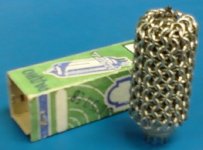I built an Aikido phono stage. Been eliminating the hum. It's gone at all listening levels. The phono stage has way more gain than I need, and if I turn the volume up all the way I can hear some hum, but at that level if I touch my turntable, I think my house might explode (it's LOUD).
So, my question.. I used tube sockets w/ shields. When I put the shields on the input tubes, I hear a dramatic decrease in hum. I'm wondering why the shields help. I can understand them blocking RF but why the 60hz sounding hum? The tubes are far from any AC (well, about 8".. the furthest I could get them on this chassis). I have the amp sitting in the middle of my living room, far away from any other electronics.
Just curious...
So, my question.. I used tube sockets w/ shields. When I put the shields on the input tubes, I hear a dramatic decrease in hum. I'm wondering why the shields help. I can understand them blocking RF but why the 60hz sounding hum? The tubes are far from any AC (well, about 8".. the furthest I could get them on this chassis). I have the amp sitting in the middle of my living room, far away from any other electronics.
Just curious...
because it's at the start of the amplification it will aways sound louder.
as you can see from touching the turntable the front end is very sensitive.
it was a very good idea to use valve cans in the pre-amp.
as you can see from touching the turntable the front end is very sensitive.
it was a very good idea to use valve cans in the pre-amp.
ok.. so it is just picking up the magnetic interference, I guess, from the TX's on the other side of the chassis? And it's so much amplification from those input tubes that the tiny tiny tiny hum is being amplified..
I was thinking about building a box around my transformers, and if that's really where the hum is coming from, it might be worth it. I'd think if the hum was coming from a wiring issue under the chassis, the shields wouldn't change the situation.
Sort of pointless because I never have the volume up high enough to hear it, but... if I can eliminate it, I guess I should.
I was thinking about building a box around my transformers, and if that's really where the hum is coming from, it might be worth it. I'd think if the hum was coming from a wiring issue under the chassis, the shields wouldn't change the situation.
Sort of pointless because I never have the volume up high enough to hear it, but... if I can eliminate it, I guess I should.
One thing is that there is no point worrying about a noise one doesn't hear at all in normal listening levels. The level of noise in itself is almost meaningless. What's important is signal-to-noise ratio, that is, how much the noise level is below the signal level, when signal is present.
Second, in case you worry about something you shouldn't worry about, you need to locate the source of the noise. It may be your phono stage, or the connection to the turntable to the stage, or both. In order to locate the source, disconnect the turntable from the phono stage, short circuit the inputs of the stage, turn the volume up and see what happens.
There are solutions to each case, but first the source of extra noise, if there is extra noise, need be located.
Second, in case you worry about something you shouldn't worry about, you need to locate the source of the noise. It may be your phono stage, or the connection to the turntable to the stage, or both. In order to locate the source, disconnect the turntable from the phono stage, short circuit the inputs of the stage, turn the volume up and see what happens.
There are solutions to each case, but first the source of extra noise, if there is extra noise, need be located.
you can add more can to the valve.........so that you get a can-can, which would also be a two-can.
OTyou can add more can to the valve.........so that you get a can-can, which would also be a two-can.
how would one go about fitting that two-can to the valve?😀😀
OT END
Attachments
Sadly, it's a messy operation for the two-can..
(I don't know why i'm perpetuating the OT 😀)
But it is a good lesson.. Do use tube cans on your first stage phono tubes! I really can't think of how else they'd make a difference if they weren't blocking the magnetic interference from the transformers across the chassis.. Didn't expect them to pick it up from so far away...
(I don't know why i'm perpetuating the OT 😀)
But it is a good lesson.. Do use tube cans on your first stage phono tubes! I really can't think of how else they'd make a difference if they weren't blocking the magnetic interference from the transformers across the chassis.. Didn't expect them to pick it up from so far away...
Macho tube shield there Kenpeter! 😀
Another test to try to help your hum... try tying the shield to either earth ground, or power ground. One will likely be better than the other.
Cheers!
Another test to try to help your hum... try tying the shield to either earth ground, or power ground. One will likely be better than the other.
Cheers!
Another trick -- if you use AC filament power -- is to reference the heater to a positive voltage, enough so the heater remains positive w.r.t. the cathode at all times.
You derive this voltage from the HT simply by using a resistive voltage divider -- say, 220K and 22K.
Or -- you have too much gain, well reduce it...
You derive this voltage from the HT simply by using a resistive voltage divider -- say, 220K and 22K.
Or -- you have too much gain, well reduce it...
is your heater ground separate from your output ground?
yes, heater ground is lifted by ~60v and is separate from the signal ground
- Status
- Not open for further replies.
- Home
- Amplifiers
- Tubes / Valves
- Tube Shield

